Appendix
Appendix 1 - Available User's Arguments
Available Starter User's Arguments
| Variable | Size | Type | Write/read | Definition |
|---|---|---|---|---|
| IIN | 1 | Integer | R | Input file unit (Starter input file) |
| IOUT | 1 | Integer | R | Output file unit (Starter output file) |
| UPARAM | NUPARAM | Float | W | User’s parameter |
| MAXNUPARAM | 1 | Integer | R | Maximum size of UPARAM |
| NUPARAM | 1 | Integer | W | Size of UPARAM |
| NUVAR | 1 | Integer | W | Number of user’s variables |
| IFUNC | NFUNCT | Integer | W | Function number array |
| MAXNFUNC | 1 | Integer | R | Maximum size of IFUNC |
| NFUNCT | 1 | Integer | W | Size of IFUNC |
| PARMAT | 3 | Float | W | (1) Stiffness modulus for interface (2) Young's modulus (for shell) (3) Poisson’s ratio (for shell) |
| Variable | Size | Type | Write/read | Definition |
|---|---|---|---|---|
| IIN | 1 | Integer | R | Input file unit (Starter input file) |
| IOUT | 1 | Integer | R | Output file unit (Starter output file) |
| UPARAM | NUPARAM | Float | W | User’s parameter |
| MAXNUPARAM | 1 | Integer | R | Maximum size of UPARAM |
| NUPARAM | 1 | Integer | W | Size of UPARAM |
| NUVAR | 1 | Integer | W | Number of user’s variables |
| IFUNC | NFUNCT | Integer | W | Function number array |
| MAXNFUNC | 1 | Integer | R | Maximum size of IFUNC |
| NFUNCT | 1 | Integer | W | Size of IFUNC |
| STIFINT | 1 | Integer | W | Stiffness modulus for interface |
| Variable | Size | Type | Write/read | Definition |
|---|---|---|---|---|
| IIN | 1 | Integer | R | Input file unit (Starter input file) |
| IOUT | 1 | Integer | R | Output file unit (Starter output file) |
| NUVAR | 1 | Integer | W | Number of user’s variables |
| UVAR | NUVAR* NEL | Float | R/W | User’s variable |
| PARGEO | * | Float | W | (1) Skew number (2) Stiffness for interface (3) Front wave option |
| NEL | 1 | Integer | R | Number of elements |
| IPROP | 1 | Integer | R | Property number |
| IX | 3* NEL | Float | R | Spring connectivity |
| XL | NEL | Float | R | Element length |
| MASS | NEL | Float | W | Element mass |
| XINER | NEL | Float | W | Element inertia (spherical) |
| STIFM | NEL | Float | W | Element stiffness (time step) |
| STIFR | NEL | Float | W | Element rotation stiffness (time step) |
| VISCM | NEL | Float | W | Element viscosity (time step) |
| VISCR | NEL | Float | W | Element rotation viscosity (time step) |
| Variable | Size | Type | Write/read | Definition |
|---|---|---|---|---|
| NEL | 1 | Integer | R | Number of elements |
| IIN | 1 | Integer | R | Input file unit (Starter input file) |
| IOUT | 1 | Integer | R | Output file unit (Starter output file) |
| NUVAR | 1 | Integer | W | Number of user’s variables |
| UVAR | NUVAR* NEL | Float | R/W | User’s variable |
| PARGEO | * | Float | W | (1) Skew number (2) Stiffness for interface (3) Front wave option |
| IPROP | 1 | Integer | R | Property number |
| IMAT | 1 | Integer | R | Material number |
| SOLID_ID | NEL | Integer | R | Solid Element id t=0 |
| EINT | NEL | Float | W | Total internal energy t=0 |
| VOL | NEL | Float | R/W | Initial volume |
| OFF | NEL | Float | R/W | Delete flag |
| RHO | NEL | Float | R/W | Density |
| SIG | 6*NEL | Float | R/W | Stress tensor |
| XX1 | NEL | Float | R | X coordinate node 1 |
| YY1 | NEL | Float | R | Y coordinate node 1 |
| ZZ1 | NEL | Float | R | Z coordinate node 1 |
| XX2 . . ZZ8 | NEL | Float | R | Same for node 2 to 8 |
| VX1 | NEL | Float | R | X velocity node 1 |
| VY1 | NEL | Float | R | Y velocity node 1 |
| VZ1 | NEL | Float | R | Z velocity node 1 |
| VRX1 | NEL | Float | R | X rotational velocity node 1 |
| VRY1 | NEL | Float | R | Y rotational velocity node 1 |
| VRZ1 | NEL | Float | R | Z rotational velocity node 1 |
| MAS1 | NEL | Float | W | Mass node 1 |
| MAS2 . . MAS8 | NEL | Float | W | Same for node 2 to 8 |
| INN1 | NEL | Float | W | Inertia node 1 |
| INN2 . . INN8 | NEL | Float | W | Same for node 2 to 8 |
| STIFM | NEL | Float | W | Element stiffness (time step) |
| STIFR | NEL | Float | W | Element rotation stiffness (time step) |
| VISCM | NEL | Float | W | Element viscosity (time step) |
| VISCR | NEL | Float | W | Element rotation viscosity (time step) |
| Variable | Size | Type | Write/read | Definition |
|---|---|---|---|---|
| IIN | 1 | Integer | R | Input file unit (Starter input file) |
| IOUT | 1 | Integer | R | Output file unit (Starter output file) |
Available Engine User's Arguments
| Variable | Size | Type | Write/read | Definition |
|---|---|---|---|---|
| NEL | 1 | Integer | R | Number of elements |
| UVAR | NUVAR* NEL | Float | R/W | User’s variable |
| UPARAM | NUPARAM | Float | W | User’s parameter |
| NUPARAM | 1 | Integer | W | Size of UPARAM |
| NUVAR | 1 | Integer | W | Number of user’s variables |
| NFUNCT | 1 | Integer | W | Size of IFUNC |
| IFUNC | NFUNCT | Integer | W | Function number array |
| NPF | * | Integer | R | Function array |
| NPT | 1 | Integer | R | Number of layers or integration points |
| IPT | 1 | Integer | R | Layer or integration point number |
| IFLAG | * | Integer | R | Geometrical flags |
| TF | * | Float | R | Function array |
| NGL | NEL | Integer | R | Element number |
| TIME | 1 | Float | R | Current time |
| TIMESTEP | 1 | Float | R | Current time step |
| RHO0 | NEL | Float | R | Initial density |
| AREA | NEL | Float | R | Area |
| EINT | NEL | Float | R | Total internal energy |
| THKLY | NEL | Float | R | Layer thickness |
| EPSPXX | NEL | Float | W | Strain rate XX |
| DEPSXX | NEL | Float | W | Strain increment XX |
| EPSXX | NEL | Float | W | Strain XX |
| SIGOXX | NEL | Float | W | Old elasto-plastic stress XX |
| SIGNXX | NEL | Float | W | New elasto-plastic stress XX |
| SIGVXX | NEL | Float | W | Viscous stress XX |
| SOUNDSP | NEL | Float | W | Sound speed (time step) |
| VISCMAX | NEL | Float | W | Max damping modulus (time step) |
| THK | NEL | Float | R/W | Thickness |
| PLA | NEL | Float | R/W | Plastic strain |
| OFF | NEL | Float | R/W | Delete flag |
| Variable | Size | Type | Write/read | Definition |
|---|---|---|---|---|
| NEL | 1 | Integer | R | Number of elements |
| UVAR | NUVAR* NEL | Float | R/W | User’s variable |
| UPARAM | NUPARAM | Float | W | User’s parameter |
| NUPARAM | 1 | Integer | W | Size of UPARAM |
| NUVAR | 1 | Integer | W | Number of user’s variables |
| NFUNCT | 1 | Integer | W | Size of IFUNC |
| IFUNC | NFUNCT | Integer | W | Function number array |
| NPF | * | Integer | R | Function array |
| TF | * | Float | R | Function array |
| NGL | NEL | Integer | R | Element number |
| TIME | 1 | Float | R | Current time |
| TIMESTEP | 1 | Float | R | Current time step |
| RHO0 | NEL | Float | R | Initial density |
| RHO | NEL | Float | R | Density |
| VOLUME | NEL | Float | R | Volume |
| EINT | NEL | Float | R | Total internal energy |
| EPSPXX | NEL | Float | W | Strain rate XX |
| DEPSXX | NEL | Float | W | Strain increment XX |
| EPSXX | NEL | Float | W | Strain XX |
| SIGOXX | NEL | Float | W | Old elasto-plastic stress XX |
| SIGNXX | NEL | Float | W | New elasto-plastic stress XX |
| SIGVXX | NEL | Float | W | Viscous stress XX |
| SOUNDSP | NEL | Float | W | Sound speed (time step) |
| VISCMAX | NEL | Float | W | Max damping modulus (time step) |
| OFF | NEL | Float | R/W | Delete flag |
| Variable | Size | Type | Write/read | Definition |
|---|---|---|---|---|
| NEL | 1 | Integer | R | Number of elements |
| IPROP | 1 | Integer | R | Property number |
| UVAR | NUVAR* NEL | Float | R/W | User’s variable |
| NUVAR | 1 | Integer | W | Number of user’s variables |
| FX | NEL | Float | R/W | Tension force |
| FY | NEL | Float | R/W | Y shear force |
| FZ | NEL | Float | R/W | Z shear force |
| XMOM | NEL | Float | R/W | Torsion moment |
| YMOM | NEL | Float | R/W | Y bending moment |
| ZMOM | NEL | Float | R/W | Z bending moment |
| EINT | NEL | Float | R/W | Total internal energy |
| OFF | NEL | Float | R/W | Delete flag |
| STIFM | NEL | Float | W | Element stiffness (time step) |
| STIFR | NEL | Float | W | Element rotation stiffness (time step) |
| VISCM | NEL | Float | W | Element viscosity (time step) |
| VISCR | NEL | Float | W | Element rotation viscosity (time step) |
| MASS | NEL | Float | W | Element mass |
| XINER | NEL | Float | W | Element inertia (spherical) |
| DT | 1 | Integer | R | Time step |
| XL | NEL | Float | R | Element length |
| XL | NEL | Float | R | Element length |
| VX | NEL | Float | R | Tension velocity |
| RY1 | NEL | Float | R | Node 1 Y bending rotational velocity |
| RZ1 | NEL | Float | R | Node 1 Z bending rotational velocity |
| RX | NEL | Float | R | Torsional velocity |
| RY2 | NEL | Float | R | Node 2 Y bending rotational velocity |
| RZ2 | NEL | Float | R | Node 2 Z bending rotational velocity |
| Variable | Size | Type | Write/read | Definition |
|---|---|---|---|---|
| NEL | 1 | Integer | R | Number of elements |
| IOUT | 1 | Integer | R | Output file unit (Engine output file) |
| UVAR | NUVAR* NEL | Float | R/W | User’s variable |
| IPROP | 1 | Integer | R | Property number |
| IMAT | 1 | Integer | R | Material number |
| SOLID_ID | NEL | Integer | R | Solid Element ID |
| EINT | NEL | Float | R | Total internal energy |
| VOL | NEL | Float | R | Initial volume |
| OFF | NEL | Float | R/W | Delete flag |
| RHO | NEL | Float | R/W | Density |
| SIG | 6* NEL | Float | R/W | Stress tensor |
| XX1 | NEL | Float | R | X coordinate node 1 |
| YY1 | NEL | Float | R | Y coordinate node 1 |
| ZZ1 | NEL | Float | R | Z coordinate node 1 |
| XX2 . . ZZ8 | NEL | Float | R | Same for node 2 to 8 |
| VX1 | NEL | Float | R | X velocity node 1 |
| VY1 | NEL | Float | R | Y velocity node 1 |
| VZ1 | NEL | Float | R | Z velocity node 1 |
| VRX1 | NEL | Float | R | X rotational velocity node 1 |
| VRY1 | NEL | Float | R | Y rotational velocity node 1 |
| VRZ1 | NEL | Float | R | Z rotational velocity node 1 |
| FX1 | NEL | Float | W | X force node 1 |
| FY1 | NEL | Float | W | Y force node 1 |
| FZ1 | NEL | Float | W | Z force node 1 |
| MX1 | NEL | Float | W | X moment node 1 |
| MY1 | NEL | Float | W | Y moment node 1 |
| MZ1 | NEL | Float | W | Z moment node 1 |
| STIFM | NEL | Float | W | Element stiffness (time step) |
| STIFR | NEL | Float | W | Element rotation stiffness (time step) |
| VISCM | NEL | Float | W | Element viscosity (time step) |
| VISCR | NEL | Float | W | Element rotation viscosity (time step) |
| Variable | Size | Type | Write/read | Definition |
|---|---|---|---|---|
| ID | NEL | Integer | R | Sensor ID |
Appendix 2 - Communication Between User's Subroutines and Radioss Code
The main functions to access user’s properties and materials are return functions and storage functions.
| Return Function | Variables | Description | |
|---|---|---|---|
INTEGER IP = GET_U_P(PID) |
PID | Integer property ID | Returns a property number. |
INTEGER PID = GET_U_PID(IP) |
IP | Property number | Returns the user property ID corresponding to the user property number IP. |
FLOAT PARAMI = GET U GEO (I,IP)
|
I | Parameter index (1 for the first parameter, …) | Returns the user geometry parameters. |
| IP | Property number | ||
INTEGER II = GET U PNU
(I,IP,KK)
|
I | Parameter index | Returns the user-stored function (if
KK=KFUNC), material
(if KK=KMAT), or property
(if KK=KPROP) numbers.
See Starter subroutine for corresponding ID storage. |
| IP | Property number | ||
| KK | Parameters KFUNC, KMAT, KPROP | ||
INTEGER IM = GET_U_M(MID) |
MID | Material ID | Returns a material number. |
INTEGER MID = GET_U_MID(IM) |
IM | Material number | Returns the user material ID corresponding to user material number IM. |
FLOAT PARAMI =
GET_U_MAT(I,IM) |
I | Parameter index | Returns the user material
parameters. Note:
GET_U_MAT(0,IMAT)
returns the density. |
| IM | Material number | ||
INTEGER IFUNCI = GET_U_MNU
(I,IM,KFUNC) |
I | Variable index | Returns the user-stored function numbers
(function referred by user’s materials). See the Starter material user’s subroutine for corresponding ID storage. |
| IM | Material number | ||
| KFUNC | Only functions are yet available | ||
FLOAT Y =
GET_U_FUNC(IFUNC,X,DYDX) |
IFUNC | Function numbered obtained by IFUNC = GET_U_MNU(I,IM,
KFUNC) or IFUNC =
GET_U_PNU(I,IP,KFUNC) |
Returns Y(X). |
| X | X value | ||
| DYDX | Slope dY/dX | ||
| Storage Function | Description |
|---|---|
INTEGER ierror = SET_U_PNU(func_index, fun_id,
KFUNC) |
Stores Radioss function fun_id in
the current user property buffer at a position referenced by
func_index. |
INTEGER ierror = SET_U_PNU(mat_index, mid,
KMAT) |
Stores Radioss material mid in
the current user property buffer at a position referenced by
mat_index. |
INTEGER ierror = SET_U_PNU(prop_index, pid,
KPROP) |
Stores Radioss property pid in the current user property buffer at a position referenced by prop_index. |
INTEGER ierror = SET_U_GEO(value_index,
value) |
Stores a value in the current user property buffer at a
position referenced by value_index. |
| Function | Variables | Description | |
|---|---|---|---|
INTEGER NUM =
GET_U_NUMSENS(ID) |
ID | Sensor ID | Allows you to get a sensor number. |
| NUM | Sensor number | ||
INTEGER ierror = GET_U_SENS_FPAR(IVAR,
VAR) |
IVAR | Float variable index | Allows you to retrieve a float sensor parameter. |
| VAR | Integer value | ||
INTEGER ierror = GET_U_SENS_IPAR(IVAR,
VAR) |
IVAR | Integer variable index | Allows you to retrieve an integer sensor parameter. |
| VAR | Integer value | ||
INTEGER ierror =
SET_U_SENS_VALUE(NSENS,IVAR,VAR) |
NSENS | Integer sensor number | Allows you to write a variable to a sensor buffer (float). |
| IVAR | Integer buffer index | ||
| VAR | Float value | ||
INTEGER ierror =
GET_U_SENS_VALUE(NSENS,IVAR,VAR) |
NSENS | Integer sensor number | Allows you to read a variable from a sensor buffer (float). |
| IVAR | Integer buffer index | ||
| VAR | Float value | ||
INTEGER ierror =
SET_U_SENS_ACTI(NSENS) |
NSENS | Integer sensor number | Allows you to activate a sensor using Radioss flag. |
FLOAT DTIME =
GET_U_SENS_ACTI(NSENS) |
DTIME | Float time delay since first activation. |
Allows you to check Radioss activation status of a sensor. |
| NSENS | Integer sensor number | ||
FLOAT TIME = GET_U_TIME() |
Allows you to check the current time. | ||
INTEGER NCYC = GET_U_CYCLE() |
Allows you to check the current cycle. | ||
INTEGER IERR = GET_U_ACCEL(NACC,
AX,AY,AZ) |
AX, AY, AZ | Float acceleration components | Allows you to access accelerometer values. |
| NACC | Integer accelerator number | ||
| IDACC | Integer accelerator ID | ||
| NACC | GET_U_NUMACC(IDACC) |
||
INTEGER IERR = GET_U_NOD_X(NOD,
X,Y,Z)
|
X, Y, Z | Float nodal coordinates | Allows you access to nodal values. |
| DX, DY, DZ | Float nodal displacements | ||
| VX, VY, VZ | Float nodal velocities | ||
| AX, AY, AZ | Float nodal accelerations | ||
| NOD | Integer node number | ||
| NID | Integer node ID | ||
| NOD | GET_U_NUMNOD(ID) |
||
FLOAT Y = GET_U_FUNC(IFUNC, X,
DERI) |
X | Float ordinate | Allows you to access Radioss functions. |
| Y | Float abscissa | ||
| DERI | Float Y/X | ||
| IFUNC | Integer function number | ||
| IDFUN | Integer function ID, where
|
||
Communication Between User's Modules and Radioss Database
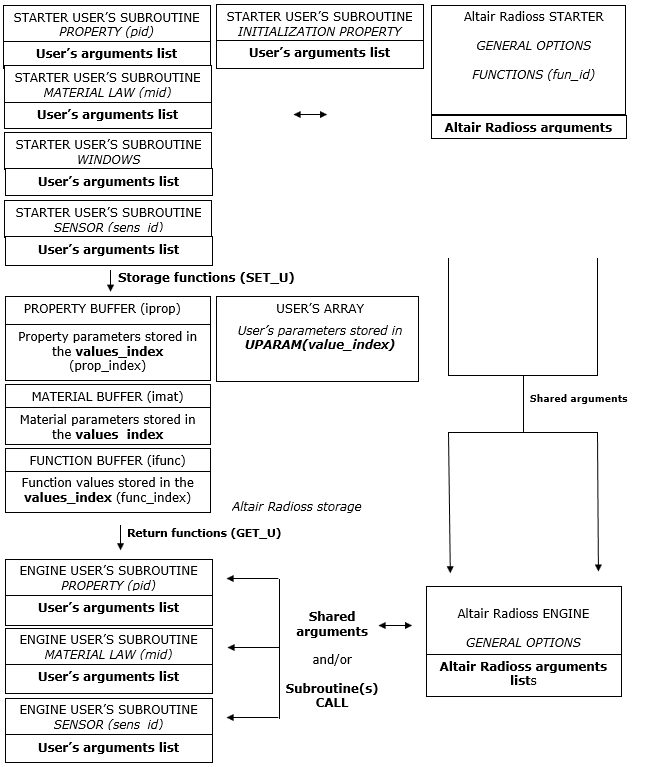
Figure 1.
Appendix 3 - General User's Subroutine Format with Material Laws 29, 30, and 31
Starter Format Example
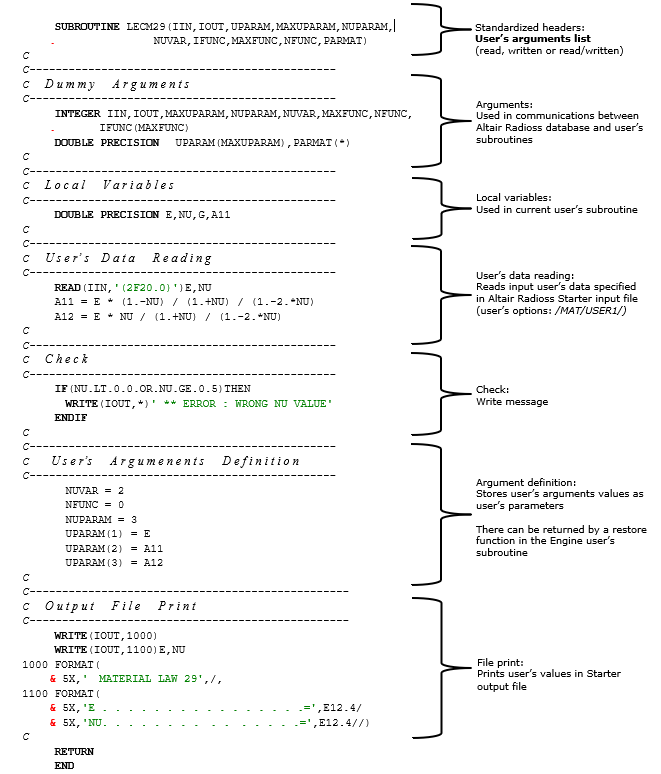
Figure 2.
Engine Format Example
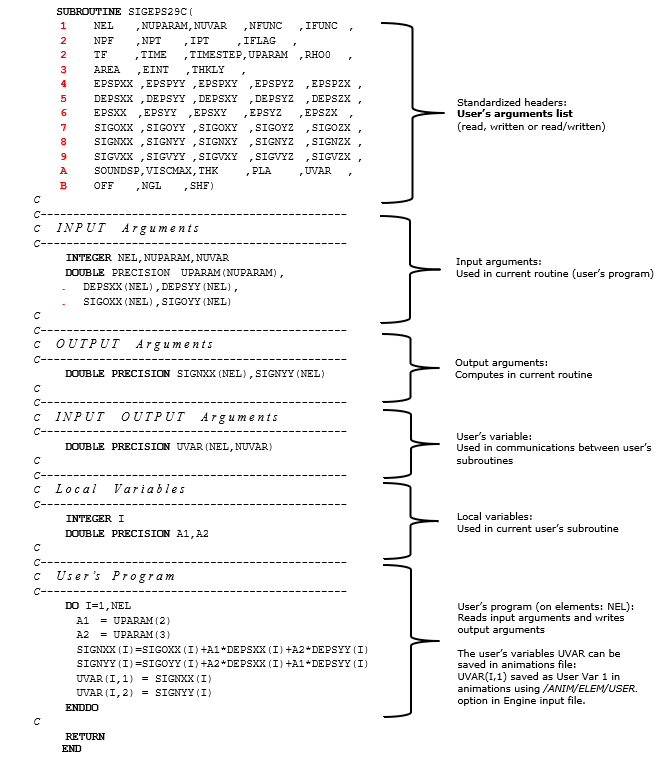
Figure 3.
Example Demo File
<install_directory>/hwsolvers/demos/radioss/User_Subroutines/7_appendix/appendix3/*
Appendix 4 - General User's Subroutine Format with Extended User Material Laws
Starter Format Example
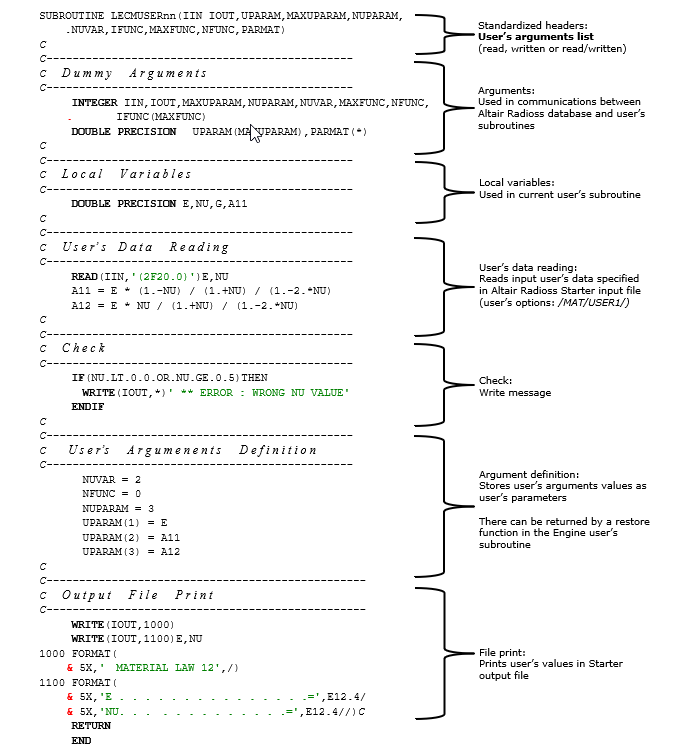
Figure 4.
Engine Format Example
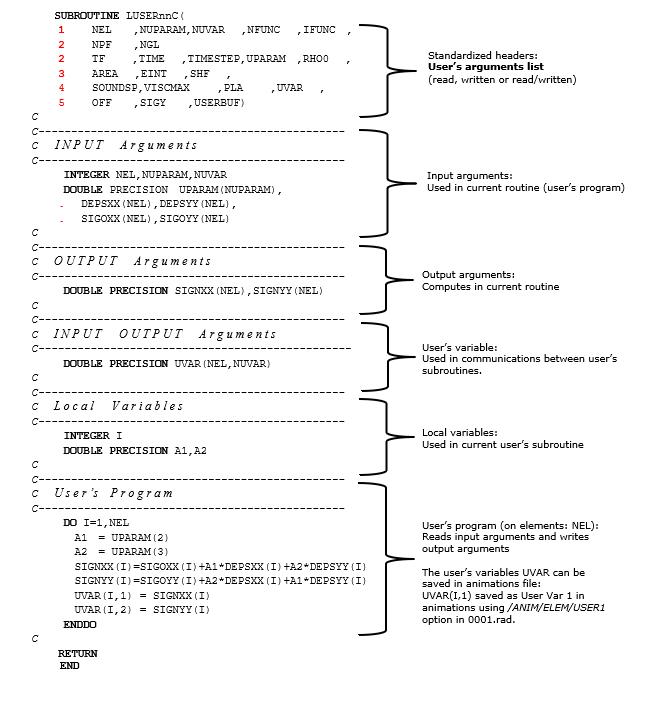
Figure 5.
Example Demo File
<install_directory>/hwsolvers/demos/radioss/User_Subroutines/7_appendix/appendix4/*